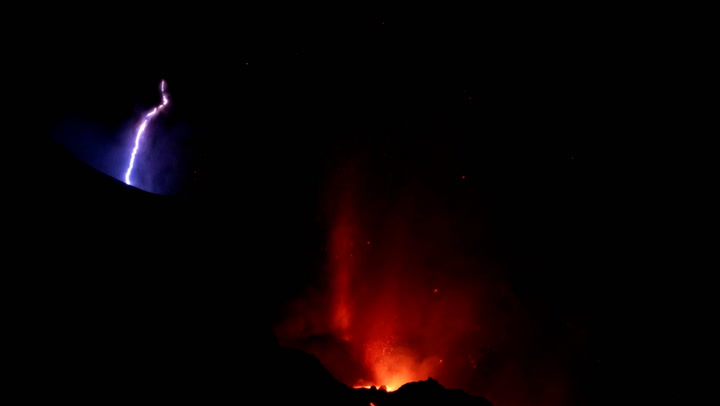
The new island of lava is now half kilometer wide (500m) and 40 meters high. And now, according to the director of the National Geographic Institute (IGN) in the Canary Islands, María José Blanco, it is in danger of cracking and collapsing into the sea.
The lava island has grown as large as the cliff it poured over and is still expending. If it continues, the delta will destabilize and could easily split and collapse into the sea, releasing gases abruptly, triggering explosions from chemical reactions, and producing large waves.
Such a collapse wouldn’t, however, trigger a dangerous tsunami that would devastate nearb islands, Europe or even the US.
Hazards of delta collapse
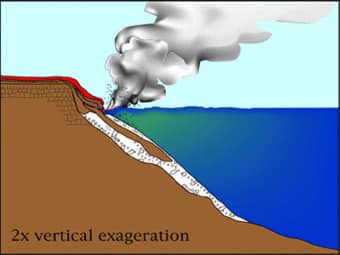
There are several hazards to this. Getting too close to an ocean entry, either on land or from the sea, is potentially deadly. Primary hazards include:
- Sudden collapse of a lava delta (new land created at ocean entry) and the adjacent sea cliff into the ocean
- Large explosions triggered by delta collapse.
- Waves of scalding hot water from ocean swells and delta collapse.
- Steam plumes that rain hydrochloric acid and tiny volcanic glass particles downwind from the entry point.
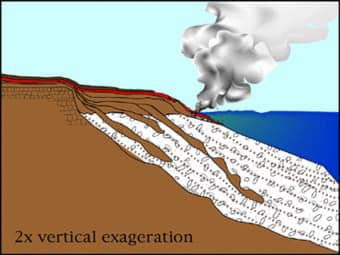
Lava deltas collapse without warning
Lava entering the ocean builds a delta on top of unstable lava fragments along the steep submarine slope. As the delta grows seaward and laterally along the shoreline, it may slowly settle or sink as the loose rock debris shifts under the weight of overlying lava flows.

All or part of the delta can collapse into the ocean when the underlying debris can no longer support the delta’s growing mass or is undercut by a deeper submarine landslide. The collapses occur suddenly or over a period of several hours.
Delta collapses can also produce waves both onshore and offshore, which can imperil boats next to a collapsing delta.
Cumbre Vieja North Face collapse
Involcan, the Canary Islands Volcanological Institute have reported that the north face of the Cumbre Vieja volcano partially collapsed on October 9, 2021.
?En la noche del viernes se produjo un derrumbe parcial de la cara norte del cono del volcán de #LaPalma con emisión de coladas en varias direcciones
Timelapse (desde las 00:00 hasta las 7:00) de @ita_dc con capturas de la cámara de @RTVCes #erupciónenLaPalma pic.twitter.com/fylDy7rRgH
— RTVC (@RTVCes) October 9, 2021
New volcanic material is flowing out in various direction and is beginning to create a new path of destruction.
Más imágenes de la nueva colada de lava que desciende por el Camino de los Campitos y el de la Vinagrera/ More footage of the new lava flow descending by the Camino de los Campitos and the La Vinagrera pic.twitter.com/bRlZAvZXMG
— INVOLCAN (@involcan) October 9, 2021
New lava ‘tongue’
A new lava ‘tongue’ is forming as one of the flows has separated from the main path and is making its own way to the sea destroying buildings and banana plantations.
Rivers of lava from the volcanic eruption on the Spanish island of La Palma swallowed at least four buildings in the village of Callejon de la Gata, according to @Reuters witnesses https://t.co/MIFFqIclPG pic.twitter.com/4VvRE6wOst
— Reuters (@Reuters) October 9, 2021
This new flow is located about 150 meters from the sea heading towards the beach of El Charcón.
Bad air quality
Yesterday, the scientific committee was concerned about air quality, which is expected to improve today due to the change in weather conditions, which will favour the dispersion of gases. The dense ash continues to thin the air in the north and east of the island, impeding air traffic.
Meanwhile, La Palma airport has reopened again:
El aeropuerto de La Palma recupera la operatividad https://t.co/rNUpsit4Bq
— Diario de Sevilla (@diariosevilla) October 9, 2021
This situation also affected Tenerife, where flights had to be diverted from north to south due to the closure of the Los Rodeos airport located in the northern part of Tenerife yesterday afternoon.
A joint research team has estimated that the Cumbre Vieja eruption is pumping out 43 tons of hydrochloric acid per day.
A scientific team made up of researchers from @involcan, @ManchesterVolc and @INGVvulcani led by @MikeBurton_Volc, estimated on October 6 the emission of hydrochloric acid (HCl) by the marine plume at 0.5 kilograms per second, equivalent to 43.2 tons per day pic.twitter.com/KD2uo3H93W
— INVOLCAN (@involcan) October 8, 2021
Volcanic lightnings
Buildings near the volcano on the Spanish island of La Palma were engulfed by rivers of lava early on Saturday, with the drama of the red-hot eruption intensified by the spectacle of flashes of lightning. The magma destroyed at least four buildings in the village of Callejon de la Gata, Reuters witnesses said.
Lightning flashes were seen near the eruption early on Saturday. A study published in 2016 by the journal Geophysical Research Letters found lightning can be produced during volcanic eruptions because the collision of ash particles creates an electrical charge.
Seismic activity continues
Another factor of concern is the incessant seismic activity. Some residents of municipalities such as Villa de Mazo or Fuencaliente have already packed bags just in case of an other eruption, even though they haven’t been advised to do so or is there any indication of one.
Within the last 48 hours, more than 180 earthquakes have been located in the eruption area; 56 of these earthquakes have been felt by the population; the largest was a M4.3 earthquake (11.17am; Oct. 7th). 14 of the earthquakes hit at depths greater than 30 km. The remaining struck at a depth of around 10km.
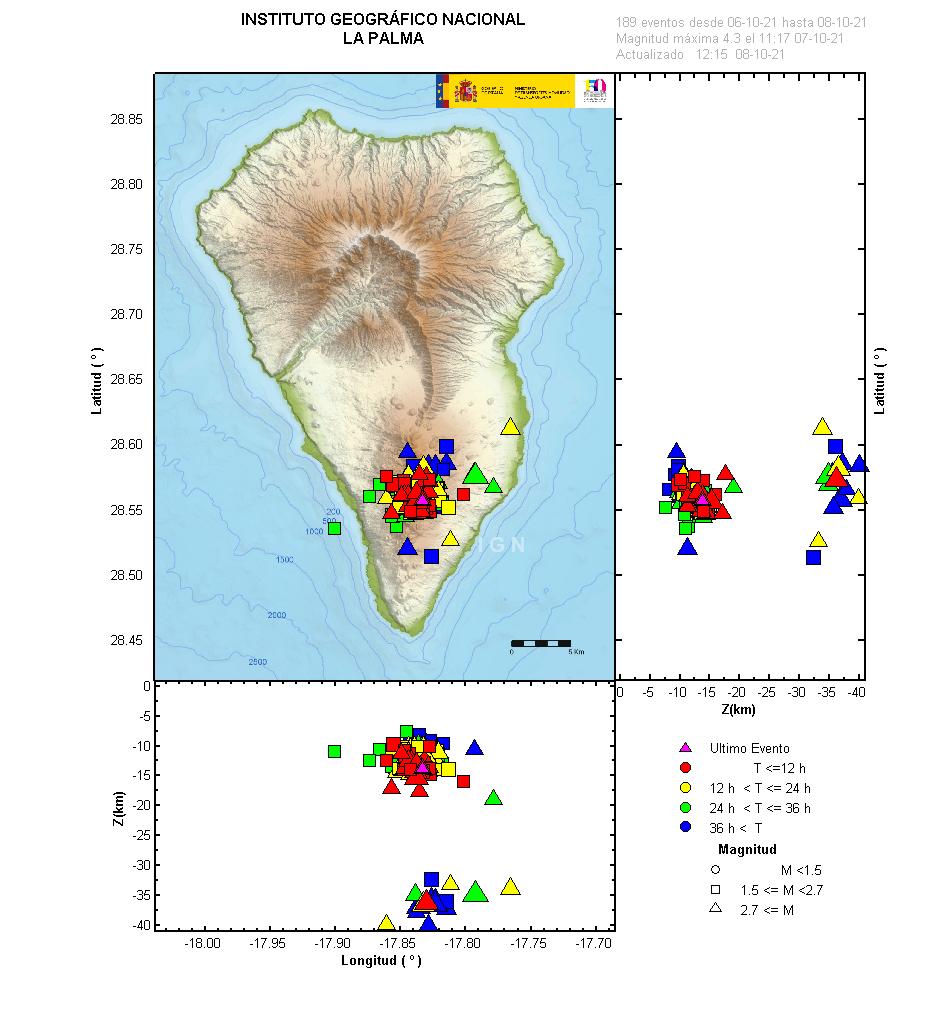
The mean amplitude of volcanic tremor remains stable in a medium to medium-high range of values. No intensification pulses have been recorded since the last report.
The Cumbre Vieja volcano began erupting on 19 September and has destroyed more than 800 buildings and forced the evacuation of about 6,000 people from their homes on the island.
The lava from the volcano has engulfed over 150 hectares (370 acres) of farm land, most of it used for the cultivation of bananas that are one of the main crops on the island.


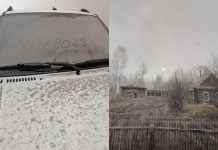










That new real estate/island forming will keep getting heavier.
Probably the shelf will buckle under that weight, I think.
That’s not good. I pray then people go fishing for a couple of weeks.
https://www.naturalnews.com/2021-10-11-fda-exposed-criminal-body-parts-cartel-organs-from-living-human-babies.html
FDA Abominations. Pretty disgusting and satanic. Time for some lightning strikes on demons.
Dear Christ, light ’em up!